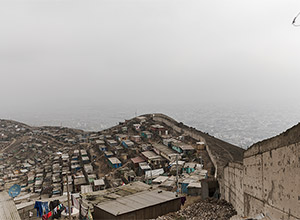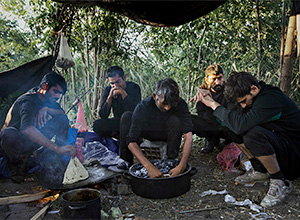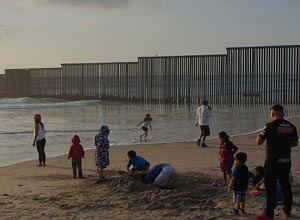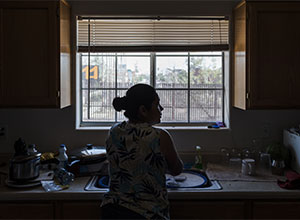POVERTY
On the Border of the Underprivileged, Those Who Escape Hunger Face Horror
10.jul.2017 - 02h00
{{video=2}}
Noor Addow, 45, his two wives and ten children walked for 17 days. As they escaped drought, hunger, terrorism and a cholera epidemic in Somalia, they only took the clothes on their backs. The children, some of them barefoot, others wearing flip-flops, had their feet covered with blisters and wounds.
Every time they came to a village, they would stop at the local mosque and beg for food. When the water in their vessels was over, they had to suck on some roots they found on their way to quench their thirst. They slept in the woods, constantly in fear of lions and hyenas.
On the 14th day, Fatma, 19, Noor's youngest wife, went into labor.
{{info=3}} [[[ARTE PIRAMIDE DEMOGRAFICA QUENIA E SOMália]]]
She was very weak. In the village where they lived in Somalia, first the dam dried out, then the corn harvest withered away and finally all their goats died. Nobody had had a proper meal in months.
Fatma gave birth under a tree. There were twins. Osman died in the middle of the night in his father's arms. Khadija passed in the morning, on her mother's lap. They did not have time to cry.
"We need to keep on walking, or we will lose more children," said Noor.
{{imagem=1}}
{{video=4}}
They walked for three more days and arrived in Dadaab, Kenya - the largest refugee camp in the world, with more than 250,000 people, most of them Somalis.
The Addow did not know it, but they were not welcome.
A year earlier, the government of Kenya had announced that it would close the Dadaab camp. President Uhuru Kenyatta said the camp had become a hotbed for terrorist group Al Shabaab - an extremist Islamic organization connected to Al Qaeda. The terrorists who killed 147 people in the attack in the university of Garissa on April 2, 2015, had come from Dadaab.
{{info=4}}
The government began a volunteer repatriation program for the refugees, despite the drought, cholera and terrorist militia who were still occupying a major part of the Somali territory. At about the same time, Kenya stopped granting the status of refugees to Somali people crossing the border.
"Before that, they used to receive the status of refugees automatically; everybody knew there was no peace in Somalia and these people were not coming here on holidays," says Jean Bosco Rushatsi, the head of operations of the United Nations High Commissioner for Refugees (UNHCR) in the Dadaab camp.
{{imagem=25}} [[[ ARTE Refugiados somalis pelo mundo + COMPARA quenianos + MAPA onde estão]]]
"After the government's decision to close the camp, nobody received the status of refugee anymore."
Without the status, the Somali also lost the perspective of being resettled in a wealthy country such Canada, Australia or the US.
The worst part is that, as they cannot be considered refugees, the Somali who arrived in Dadaab in the last two years have not received the settlement package, which includes a piece of land and material to build their tents.
They do not receive even the "ration card", a card that grants them grains, flour, oil, sugar, salt and some money to buy fruit and vegetables every two weeks.
Without the biweekly ration card, Noor's family has survived on boiled leaves since they arrived, a little over a month ago. Every day, their oldest daughter collects leaves in the woods and boils them in a pot until it becomes a green, viscous mush.
"It is pretty salty, the taste isn't bad," says Abay, their 20-year-old daughter.
When he arrived in Dadaab, Noor thought he had hit the jackpot. He found a piece of land with two tents whose residents had just been sent back to Somalia.
{{mosaico=1}}
The ten-member family occupied the improvised manyattas, whose walls were made of dry acacia branches tied together with strips of garbage bags and covered with tarp donated by humanitarian organizations and cardboard.
The furniture includes only mats on the floor. Inside the tents, there was an unimaginable mass of flies. In the corner, there was a toilet built by an NGO.
A fence made of dried acacia branches, covered in thorns and countless old clothes and rags surrounds the area. The old clothes are used to scare away the hyenas. The sneaky hyenas are always nearby during the night and prey on the goats. Sometimes they kill the babies.
Noor was happy to receive the tents but soon found out that he would not be entitled to the ration card. The family lived on food donated by neighbors and boiled leaves for an entire month. Most Somalis are Muslim and follow strictly Mohamed's teachings of helping the poor.
{{imagem=15}}
{{info=1}} [[[ARTE MAPA DA FOME NA SOMÁLIA]]
{{info=2}} [[[ARTE MAPA DA COLERA NA SOMÁLIA]]
Then Noor finally received the token - a way the UNHCR uses to give at least some food to families in great need who do not have the status of refugees.
A pleased Noor was preparing to wake up at 4:00 a.m. and wait in the mile-long line to the warehouses kept by the World Food Program. He would leave the warehouse with a small amount of beans and corn.
Despite all the hardship, Dadaab is still better than Somalia for the Addows.
"At least we have water here," said Habiba, the family's 13-year-old daughter, pushing a wheel cart with some pots. They also have access to medical care. Salado, aged two, has malaria and has just come back from the hospital. The small, weak child has thin arms and a protuberant belly, marks of the chronic malnutrition.
{{mosaico=2}}
{{mosaico=3}}
{{mosaico=4}}
{{imagem=12}}
In Kenya, refugees are not allowed to work or leave the fields. They make a living by doing small informal jobs.
"My wife spent all day washing clothes for other people and managed to get a bag of rice for that. I do nothing other than wait for the food token," says Noor.
He says he would love to go to "America", where many Somalis live. When he is told that the country's current president, Donald Trump, has made it harder for refugees to enter the country, Noor frowns. "I did not know that."
Nor did he know that the government of Kenya is closing the refugee camps. "We have just arrived. I don't know what we will do if they send us back to Somalia. We are shepherds and farmers, we cannot go back to that dry land."
{{video=3}} [[[[VIDEOGRAFICO]]]]
{{imagem=27}} [[[ARTE - ESTADOS FALIDOS]]]
Since 2014, Kenya has promoted the volunteer repatriation of 75,000 Somalis living in Dadaab. Two of the five camps in the complex have been closed.
The United Nations says that 6.2 million people from Somalia need humanitarian help today. That corresponds to nearly half of the country's population. In the last major hunger wave, in 2011, 260,000 people died of starvation. Many people are in danger again.
"They are going to close the camps and sent the people back to a country where there is no medical care or schools and there is a cholera epidemic," says Liesbeth Aelbrecht, the leader of the Doctors Without Borders mission in Kenya.
The refugees' life is likely to become even more difficult.
The government of Kenya is building a 700-kilometer fence on the border with Somalia to stop more Somalis from entering the country. The goal is to prevent terrorist attacks organized by the Al Shabaab Islamic militia.
Public servant Saadia Kullow, 29, of Kenya, commemorates the project to build the fence. She lives in Mandera, a city of 150,000 residents on the tri-border of Kenya, Ethiopia and Somalia.
{{imagem=13}}
Mandera has lived under siege for months due to the Al Shabaab attacks. There is a curfew between 7:00 p.m. and 6:00 a.m. - anyone in the streets during these hours is arrested.
Foreigners are not allowed to enter the city because it is not safe.
Representatives of the government and visitors only travel in the country escorted by cars with bodyguards carrying machine guns. The last attack occurred at the end of May. A bomb was used against a car convoy taking the county's governor - five bodyguards died in the attack.
Saadia, who has lived in Mandera since she was born, has seen five attacks to date. In the last one, bombs exploded a few meters away from her house. Every time a truck drives along the street or there is a loud noise, her two-year-old son still wakes up shouting: "Mommy, mommy, bomb!"
{{info=6}} [[mapa/ dados mandera]]]
{{imagem=17}}
"The tension is always in the air and we never know when they will attack. But they will. That is why this wall will be great."
Today the border between Kenya and Somalia is porous and weapon dealers, sugar smugglers and extremists take advantage of it.
{{imagem=24}} [[ARTE comparativo raio-x Somália X raio-x Quênia]]]
Hundreds of people cross from Somalia to Kenya every day to work, visit relatives and search for greener fields for their herds. If they are unlucky enough to come across a police officer on their way, Somalis know that all it takes to get to the other side is a bribe of some 50 Kenyan shillings (some US$ 0.5).
The construction of the fence began in 2014; however, only 5.3 kilometers have been built so far.
Even so, it represents an obstacle.
{{video=1}}
{{imagem=26}} [[[ARTE - PRESENÇA AL-SHABAB / MAPA]]
In the settlement of BP1 (short for Border Point 1, as it is the first point of one of the most volatile borders in the world) goat shepherds cannot cross so easily to Somalia anymore as they search for green fields, which are becoming increasingly scarce.
Most Somali children study in Kenya because there are not many schools open in Somalia. Before the wall, they just had to cross the border. Now they need to walk 12 kilometers to go and 12 more on their way back as they go around the fence and reach school.
"This border is artificial, our community is in fact one: the same language, the same people, the same religion," says the leader of BP1, Mohammad Salat. In the north of Kenya, the population is ethnically Somali and the predominantly Muslim – unlike most Kenyans, who are Christian. Up until 1925, this area was part of the Somali region of Jubaland.
Fredrick Shisia, a commissioner of the Mandera county, says that the purpose of the fence is not to divide Somalis and Kenyans, but to prevent terrorists from crossing the border. The Al Shabaab organization usually attacks Christians and government employees, as well as Kenyan soldiers and police officers.
Kenyan troops have been fighting the Al Shabaab in Somalia since 2011.
Shisia admits that the fence will make it difficult for Somali refugees to enter. "But Somalia has been a lot more stable; we have been encouraging Somalis to go back home, because nobody will rebuild the country if they don't go back."
{{mosaico=6}}
{{mosaico=7}}
And, anyway, "this huge number of refugees is a burden on our economy," says Shisia. "If it is difficult for Europe, can you even imagine how difficult it is for us?".
Unlike Europe and the United States, where the governments also built walls to stop the inflow of refugees, Kenya is not a wealthy country.
Somalia has the lowest per capita income in the world: US$ 400 per year.
In Kenya, the per capita income is eight times that of Somalia. Even so, Kenya is number 185 in 230 countries. Its US$ 3,400 annual income per person corresponds to 25% of the annual per capita income of Brazilians.
{{imagem=14}}
In the county of Mandera, the illiteracy rate reaches 75% of the population. There are no asphalted roads. More than half of the county's children suffer of malnutrition. There is only one doctor for every 114,000 inhabitants.
"Instead of criticizing the end of the camps and the fence under construction, the international community should try to understand that Dadaab has become a terrorist snake pit," says Harun Kamal, the deputy commissioner of the county of Garissa, where Dadaab is located. "The wealthy countries should offer to receive five or ten thousand Somali refugees."






